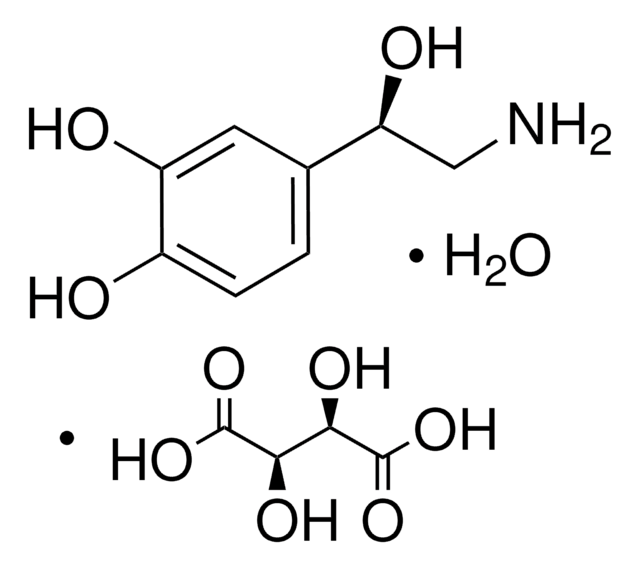A7257
(−)-Norepinephrine
≥98% (TLC), crystalline, adrenergic neurotransmitter
Synonym(s):
(R)-4-(2-Amino-1-hydroxyethyl)-1,2-benzenediol, L-Arterenol, L-Noradrenaline, Levarterenol
Select a Size
Select a Size
About This Item
Recommended Products
Product Name
(−)-Norepinephrine, ≥98%, crystalline
assay
≥98%
form
crystalline
color
off-white to tan
storage temp.
−20°C
SMILES string
NC[C@H](O)c1ccc(O)c(O)c1
InChI
1S/C8H11NO3/c9-4-8(12)5-1-2-6(10)7(11)3-5/h1-3,8,10-12H,4,9H2/t8-/m0/s1
InChI key
SFLSHLFXELFNJZ-QMMMGPOBSA-N
Gene Information
human ... ADRA1A(148) , ADRA1B(147) , ADRA1D(146) , ADRA2A(150) , ADRA2B(151) , ADRA2C(152) , ADRB1(153) , ADRB2(154) , ADRB3(155)
rat ... Adra1a(29412) , Adra1d(29413) , Adra2a(25083) , Adrb1(24925) , Adrb2(24176) , Drd1a(24316) , Drd2(24318)
Looking for similar products? Visit Product Comparison Guide
Related Categories
General description
Application
- as anαand β-AR agonist to stimulate mouse organoids to study the pathways that are activated upon intestinal epithelial adrenergic receptor (AR) stimulation,
- to measure the monoamine levels in various limbic regions of mouse brains by high-performance liquid chromatography (HPLC) coupled with an electrochemical equipped with an auto-sampler,
- as a dispersal agent in biofilm dispersion assay to study its effects on the dispersal of Mannheimia haemolytica biofilms
Features and Benefits
signalword
Danger
hcodes
Hazard Classifications
Acute Tox. 1 Inhalation - Acute Tox. 2 Dermal - Acute Tox. 2 Oral
Storage Class
6.1B - Non-combustible acute toxic Cat. 1 and 2 / very toxic hazardous materials
wgk_germany
WGK 3
ppe
Eyeshields, Faceshields, Gloves, type P3 (EN 143) respirator cartridges
Choose from one of the most recent versions:
Certificates of Analysis (COA)
Don't see the Right Version?
If you require a particular version, you can look up a specific certificate by the Lot or Batch number.
Already Own This Product?
Find documentation for the products that you have recently purchased in the Document Library.
Customers Also Viewed
Articles
DISCOVER Bioactive Small Molecules for Neuroscience
Our team of scientists has experience in all areas of research including Life Science, Material Science, Chemical Synthesis, Chromatography, Analytical and many others.
Contact Technical Service










